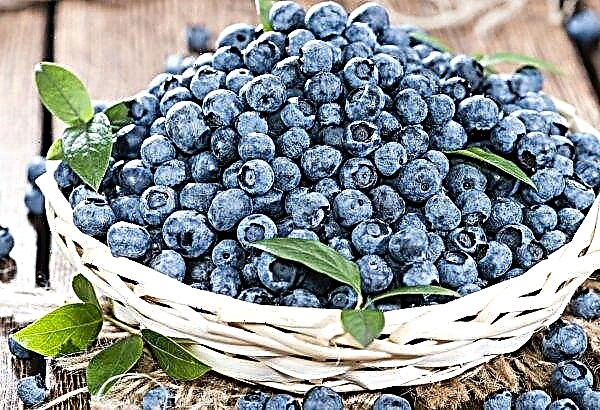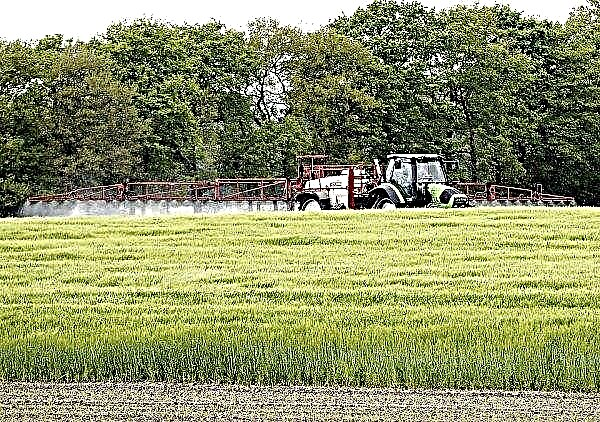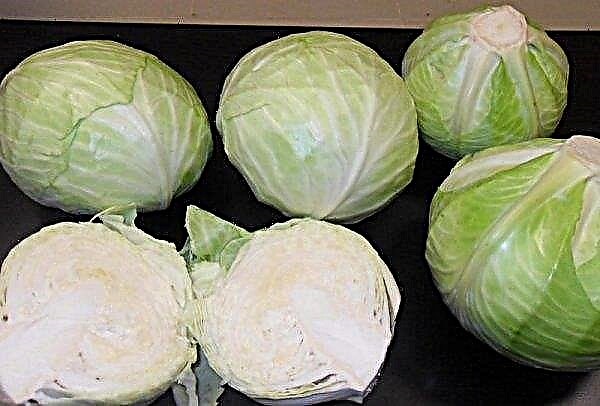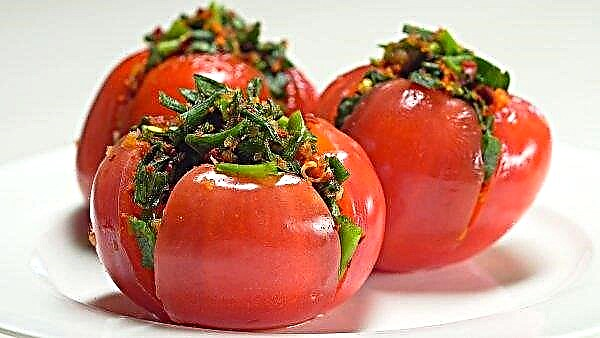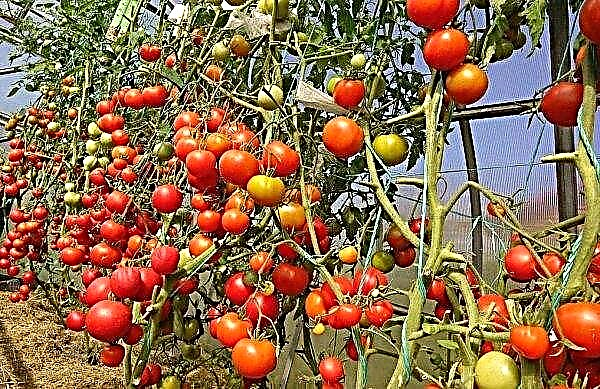Medlar belongs to the family Rosaceae, is the closest relative of the apple tree. In America, grown as an ornamental tree, in Japan, China is a full-fledged fruit variety. In our latitudes indoor representatives are popular, which bloom and bear fruit. Let us consider in more detail their general characteristics and the rules of agricultural technology.
Description and properties of the plant
Japanese medlar is an evergreen tree or bush. Height varies between 2–7 m. The crown is thick, spreading. The leaves have a leathery structure, elliptical in shape. Leaf plates - bare or slightly pubescent. Outwardly resemble the leaves of an apple tree. Their length is 25 cm.  The flowers are white with yellow, exude a pleasant sweet aroma with almond notes. Inflorescences are collected in the axils of young or last year's branches in a column. Externally, the flowering of medlar is similar to chestnut. Each corolla consists of 5 petals and more than 40 stamens. Forms 2 ovaries.
The flowers are white with yellow, exude a pleasant sweet aroma with almond notes. Inflorescences are collected in the axils of young or last year's branches in a column. Externally, the flowering of medlar is similar to chestnut. Each corolla consists of 5 petals and more than 40 stamens. Forms 2 ovaries.
Fruits are spherical or pear-shaped, 6–8 cm in diameter. Orange and yellow. They taste like a mixture of pears and cherries. Inside there are 2–4 bones.Important! Medlar blooms, unlike other fruit trees, in autumn and winter, so in regions with cool winters it is better to grow it in pots at home or in greenhouse conditions.
In our country, the plant is more often used for landscaping park areas. Medlar is used in regions of natural distribution as a medicinal plant and dietary food product.
Photo gallery
The main aspects of the botanical description of the plant:
| Root system | Ramified |
| Growth form | Tree, bush |
| Leaf shape | Elliptical |
| Leaf color | Dark green |
| Flower shape | Cupped |
| Flower color | White with yellowness |
| Fruit shape | Spherical, pear-shaped |
| Fruit color | Orange yellow |
| Fruit flavor | Sweet and sour |
Beneficial features
Useful features of medlar:
- decoctions of leaves are used as an analogue of mucolytic and antiviral drugs;
- at the beginning of ripening, the fruits accumulate a large amount of tannins and have an astringent effect on diarrhea;
- in ripe fruits, tannins are replaced by amino acids and vitamins, have a mild laxative effect;
- substances contained in ripe fruits have an effect on the internal secretory organs;
- the product is valued for low calorie content and is often part of the diet and during therapeutic fasting;
- from dried seeds make decoctions used in the treatment of gastrointestinal dysfunction, urolithiasis;
- from bark make medicinal drugs for external use;
- fruits, leaves, bark and seed are actively used in cosmetology for the manufacture of masks, lotions, anti-aging creams.
Did you know? The first aspirin tablet was made from compounds extracted from willow bark. And in the UK, drugs for the treatment of cancer are made from yew trees. Residents of this country have the right to donate yew, which grows in their yard, to charity to provide patients with the necessary drugs.
Harm and contraindications
Medlar has contraindications and side effects:
- gastrointestinal dysfunction, accompanied by an increase in acidity and ulcerative lesions of the mucosa;
- individual intolerance;
- not ripened fruits are contraindicated for people suffering from constipation.
 If the product is abused, allergic reactions in the form of urticaria are possible. From the gastrointestinal tract, diarrhea, cramping, and vomiting can be observed.
If the product is abused, allergic reactions in the form of urticaria are possible. From the gastrointestinal tract, diarrhea, cramping, and vomiting can be observed.
Rules for growing indoors
Provisions that will tell you how to grow a medlar at home in a pot:
- Choose a suitable variety for home breeding (Tanaka, Premier, Champagne).
- Organize the habitat correctly, taking care of the sufficient supply of light, maintaining positive temperature and high humidity.
- The plant responds well to regular dressing during the warm season.
- Follow transplant rules.
- Choose a method of plant propagation.
Planting and care at home
Growing medlar in the garden is permissible in the southern regions, where in winter the air temperature does not drop below +2 ° С. In other cases, the tree is bred at home in pots. Landing is carried out in the fall. The easiest way is to buy a four-year-old seedling in the nursery. It will bloom in the first year after planting. After planting, the task of the grower is to properly care for the tree and provide conditions that are close to natural.
After planting, the task of the grower is to properly care for the tree and provide conditions that are close to natural.
Seat selection
Medlar is a photophilous plant, so it will feel good on the south or east window.
Humidity and temperature
At home cultivation, the air temperature should be maintained within the range of +18 ... + 25 ° С. In summer, you can put the plant on an open balcony or in the garden. Humidity level - 70%.
Lighting
Plants tolerate direct sunlight.
At the end of January, the time of re-exposure is gradually reduced.Important! Beginning in late autumn and winter, medlar needs additional illumination. Without illumination, the plant will not be able to pollinate and will not produce fruit.

Priming
Soil for medlar can be bought at the store. Suitable substrate for palm trees or roses. In order for the plant to bear fruit, a soil enriched with humus is required, which passes moisture well. The substrate can be made independently by mixing in the proportions 2: 1: 1: 0.5:
- humus;
- turf land;
- peat;
- sand.
Pot selection and planting
The pot is picked up wide. Depth is calculated by the size of the rhizome. It grows strongly to the sides and has additional branches in the upper layers of the soil.
Expanded clay is placed at the bottom of the pot, filling the tank by 1/3. Then lay out a layer of soil and form a small tubercle on it. Before planting, the root system must be immersed for 2–3 hours in the Kornevin solution. The roots are neatly spread over the tubercle and align the plant along the root neck so that it rises 5-7 cm above the ground. When filling the roots with soil, make sure that no gaps form.
Irrigation
Medlar needs regular abundant irrigation with warm, decanted water. Watering is carried out on demand. After each water treatment, it is necessary to loosen the soil to enable the roots to receive oxygen.
Transplant and pruning
During the first 3-4 years, transplantation is carried out annually in the spring. Each time the pot is taken 2 cm larger than the previous one. After 4 years of life, the plant needs a transplant once every 3 years, and from the 7th year only the upper earth layer (15–20 cm) is replaced.
Initially, transplantation is carried out by the transshipment method, with the preservation of the old earth lump. For this, the plant is pre-watered and left overnight. In the morning, in a prepared pot filled with expanded clay and soil to half, carefully move the plant. The voids on the sides are filled with earth, necessarily tracking the position of the root neck. To form a bush, pinch the growth point 1.5 weeks after planting. Pinch the tree growth point 1.5 years after planting to reduce the speed of the plant pulling up.
To form a bush, pinch the growth point 1.5 weeks after planting. Pinch the tree growth point 1.5 years after planting to reduce the speed of the plant pulling up.
Medlar is suitable for the formation of bonsai, especially if you plant several plants in one tank at once. Trees well tolerate mechanical damage caused during pruning, and can be easily formed.
Did you know? A bonsai of record small size reaches 2.5 cm in height.
Breeding methods
Medlar at home reproduces in three ways:
- Cuttings.
- The seeds.
- Layering.
Cuttings
Cuttings are separated from plants at a temperature of +10 ° C. They are planted on other fruit trees or sprouted in the ground, and then grown as an independent culture. Biomaterial is cut from the tops of strong shoots, counting 3-5 healthy kidneys. The cut stalk is treated with “Kornevin” and placed in a moist substrate. From above it is covered with a glass jar of a suitable size or a cut plastic bottle. The container with the shoot is put in a dark warm place. The jar can be removed when the shoot takes root. You can find out by the appearance of new kidneys.
The cut stalk is treated with “Kornevin” and placed in a moist substrate. From above it is covered with a glass jar of a suitable size or a cut plastic bottle. The container with the shoot is put in a dark warm place. The jar can be removed when the shoot takes root. You can find out by the appearance of new kidneys.
Vaccination is carried out in early spring. As a stock you can use a pear, an apple tree that has already been fruited. The stock is cut off, leaving a stump. Sharpened cuttings are inserted into the space between the bark and cambium, treated with garden varieties and fixed with a bandage. When new leaves appear on the sprouts, you can remove the coil.Another method to improve the culture is to plant it on a young tree. An incision with a notch is made on the side of the cortex, at a height of 10 cm from the root neck. Medlar stalk is ground under this recess. Having inserted the handle, the wound surface is treated with garden varieties and a new branch is wound with electrical tape. By planting a plant on dwarf winter-hardy varieties of fruit trees, it is possible to improve the species diversity and genetic data of medlar, which will greatly facilitate the work with the plant and allow it to be planted in open areas.
By planting a plant on dwarf winter-hardy varieties of fruit trees, it is possible to improve the species diversity and genetic data of medlar, which will greatly facilitate the work with the plant and allow it to be planted in open areas.
Seeds
The method of propagation by seeds is considered the most effective, since the parental characteristics are preserved in a young plant. Seed is extracted from the fetus and placed for 2 hours in a solution with a growth stimulant. Pots for planting take a volume of 1.5–2 liters. They place drainage and sand-peat mixture. The seeds are buried by 2–4 cm, moistened abundantly and covered with polyethylene. Daily film is removed for 20-30 minutes. for airing. When the first sprouts appear, the cover is removed. After the formation of 3 full-fledged leaves, seedlings are planted in different containers. In the future, standard care.
Pots for planting take a volume of 1.5–2 liters. They place drainage and sand-peat mixture. The seeds are buried by 2–4 cm, moistened abundantly and covered with polyethylene. Daily film is removed for 20-30 minutes. for airing. When the first sprouts appear, the cover is removed. After the formation of 3 full-fledged leaves, seedlings are planted in different containers. In the future, standard care.
Layering
By layering, medlar propagates only at home, provided that its branches are strongly tilted down. They select the lowest branch and carefully, pulling it down, sprinkle with a substrate. At the junction with the stem, make a small incision so that future layering does not grow crookedly. As soon as the shoot is firmly rooted, it is completely cut off from the mother tree and dive into a separate container.
Pests and diseases
Possible diseases and their causes:
- Leaf spotting - improper care, waterlogging. Pathogens are fungal spores that multiply in the soil and are able to remain in its upper layers for a long time. The leaves become stained, turn yellow and lose their density. An unpleasant odor emanates from a lump of earth in the pot. The solution to the problem is an urgent transplant with a complete replacement of an earthen coma, the removal of rotten roots and treatment with a disinfectant solution (manganese, copper sulfate, Bordeaux fluid).
- If the leaves of medlar dry, this is the first signal of a lack of moisture, vitamin deficiency or pest damage. Carefully check the earthen feed and adjust the watering mode. Fertilize the soil 2 times a month the entire warm season with complex fertilizers for palm trees.
- Sooty fungus. Pathogen - fungal spores that multiply in a warm environment. Plaque appears on the leaves in the form of soot, which prevents photosynthesis. A moisture reduction of up to 50% in combination with vitamin-mineral top dressing and manual removal of soot with a wet swab allows you to get rid of the problem. Fungicides in this case give a bad result and only stop the development of the fungus.
 Pests:
Pests:
- scale shield;
- aphid.
Thus, this oriental tree is one of the few that does not require special care. Therefore, it can be bred both as a decorative and as a home fruiting plant.Important! In medlar, the lower layer of foliage begins to dry as it grows. This is a natural process. You just need to remove these leaves. This will give the plant the opportunity to fully develop new foliage.




